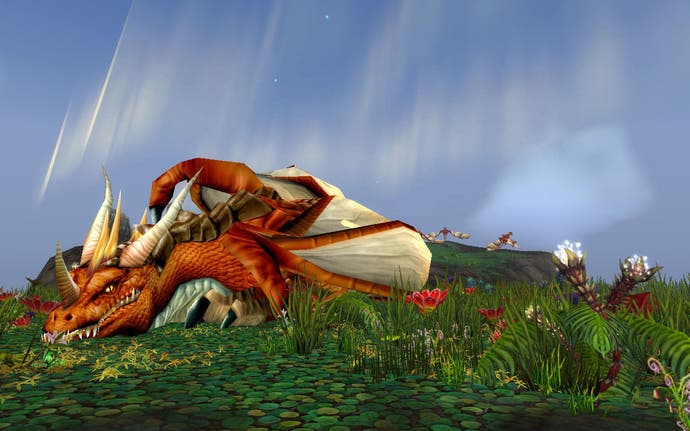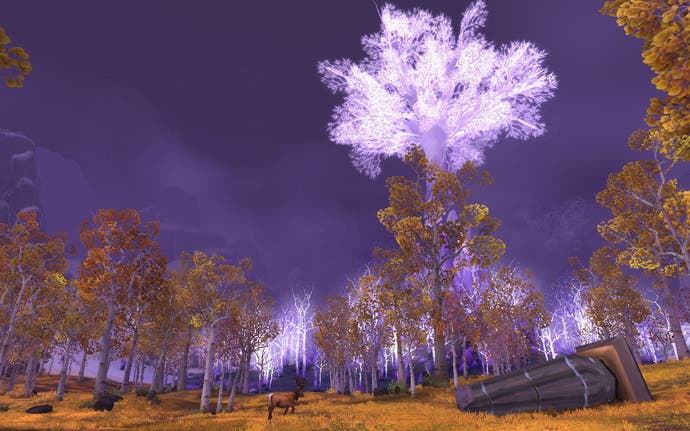World of Warcraft: Wrath of the Lich King
Beta Report Part 3: Exploring Northrend.
Easy mode. That's what MMO veterans of EverQuest and its ilk like to call World of Warcraft, and to some extent - when it comes to death penalties, ease of soloing and generous quest rewards - they're right. Warhammer Online has stripped things back even further, with instant respawns, easy teleportation around the world map, and content carefully sculpted into a non-stop waterslide of experience points. Could the next WOW expansion, Wrath of the Lich King, go any further?
Well, yes and no. In Blizzard's enthusiasm to clean the slate and put every player back on a level playing field for the expansion, early Lich King quests shower you in gear that easily replaces all but the best Burning Crusade equipment. Furthermore, there's the controversial move to make all high-end raids accessible to teams of just ten players. But there's one area in which WOW has always been uncompromising: travel and exploration.
WOW is an explorer's game. With its huge, exquisitely crafted play-fields, minimal instancing or invisible walls, and insistence on lengthy real-time travel, it always has been. Wrath of the Lich King is no different. More so than the Burning Crusade's Outland, more so even than some of classic WOW's two landmasses, the new continent of Northrend has been created as a journey. No, scratch that - an expedition.
The twin starting zones at the eastern and western extremities of Northrend, Howling Fjord and Borean Tundra, are already well-documented. But the choice between them isn't an easy one. Howling Fjord is home to the lowest-level dungeon - Vrykul fortress Utgarde Keep, quite reminiscent of Hellfire Ramparts - and it arguably has the more densely-packed, sophisticated and rewarding quest lines. Despite the zone's size, it's efficiently crammed around the spectacular, intimidating Utgarde where it plunges from the Fjord's high cliff-tops to the sea. The fight focuses on the struggle with the warlike Vrykul.

Borean Tundra is a vast, open expanse of coastline, windswept moorland and hot springs, more thinly populated than Howling Fjord, but more easily navigable. Questing centres on the struggle with the wilderness and helping out the Tuskarr, the friendly and adorable race of walrus-men whose giant sea-turtle transports connect the Tundra and the Fjord via the vast Dragonblight zone between them.
You'll also encounter the mages of Dalaran here, and the first stages of the fight against the Blue Dragonflight and its mage hunters, who aim to stamp out all magic use from the world. This battle centres on the offshore island Coldarra and the Nexus dungeon, an obscenely pretty, crystalline structure containing some of the most breathtaking sights in WOW to date. Overall, the Tundra seems less structured than Howling Fjord, but offers a more powerful, alien atmosphere that's quite distinct from anything in the game to date. If you're more bothered about a sense of the new than speedy progress, this is the place to be.
What you won't be doing is pressing straight on to the new capital city Dalaran, and establishing a base of operations there. Although there is a shortcut involving the services of a friendly mage, Blizzard is quite deliberately withholding any sense of being at home in Northrend from players; Dalaran is mostly inaccessible until the mid-70s at the earliest. Instead, you'll be returning to the main Alliance and Horde bases in Howling Fjord and Borean Tundra, and from there using regular transports back to the mainlands to trade and train. There's some inconvenience involved, but the ports have most services you need - and you feel very much like you're clinging to the edges of this new continent, pushing into it with your allies.

The vast new zones are very liberally scattered with flight paths, even to the smallest settlements, and there are fewer neutral towns and common quest lines; the division between Alliance and Horde was nebulous at best in Burning Crusade, but has been reinforced this time around. With no handholding questing indicators, adventurousness and good orienteering are still prerequisites, but once you've done your initial exploring, backtracking and tedious travel times are reduced.
After the two initial zones, players from both ends of the continent are led towards Dragonblight. This, in many ways, is the heart and soul of the new continent, and the largest single zone Blizzard has created to date. A mixture of melancholy, snowbound forest, iced-over dragon graveyards and the shrines of various dragonflights, Dragonblight is also where the fight against the Scourge begins in earnest with the epic Wrath Gate quest lines, culminating in players' first encounter with the Lich King himself.

Every storyline and theme of the expansion meets here, including the steady unveiling of the secrets of the Titans, creators of the world. In the early-to-mid-70s, Dragonblight is where you'll be spending all your time. In addition, there are the underground dungeons of Azjol-Nerub, where the insectoid Nerubians are struggling to free themselves from the Lich King's control, and high-end raid zone Wyrmrest Temple.
The next two zones are perhaps the two most familiar and conventional in the expansion. Sholazar Basin in the west is a tropical crater recalling Un'Goro in the classic game; Grizzly Hills, as we remarked when we first previewed Lich King, is almost an all-in-one homage to the mountain ranges and forests of classic WOW. It's the music that conjures a new atmosphere in these two zones, more so even than the rest of the continent, although the score is superb throughout. Grizzly Hills' lilting bluegrass fiddle themes are pure North American nostalgia.









